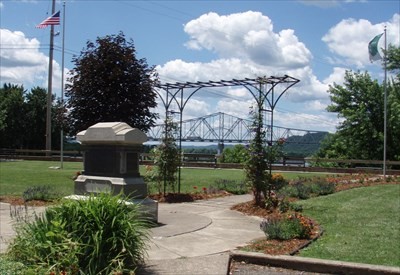Alexandria Point Park & Alexandria Stone
Introduction
Text-to-speech Audio
In 1931, a local historian found a rock that dated back to the early 19th century from a lost village called Alexandria. During a civic celebration 1938, the people of Portsmouth dedicated this rock in a small park where the village of Alexandria was located-- the confluence of the Ohio and Scioto River. During the celebration, the Portsmouth Recreation Department named the park Alexandria Point Park, and this rock was named the Alexandria Stone.
Images
View of the Ohio River

Entrance to the park

Where the two rivers meet


Backstory and Context
Text-to-speech Audio
Squire Oscar Foster discovered the markings on this stone in 1931. For years, the stone had been used as a family's porch step. Foster gave the stone to local historian Alfred Fagan, who then gave the stone to the city. The people of Portsmouth decided to celebrate the history of the village of Alexandra with a ceremonial dedication of the stone. The rock was carried through town and placed in front of a flagpole, and this is where the stone can be found today.
The Alexandria Stone has inscribed the letters E.L and the date of 1802. The E.L stands for Elias Langham, who was the first person to survey the land of Alexandria. While Elias Langham helped survey the land, he never lived in Alexandria. Still, his computation of the town was so important that this stone was possibly carved for him.
This land was always important for different groups of people. The Adena, Hopewell, and Shawnee lived here before Alexandria was ever laid out. The last people that lived in the land were the Shawnee, and they had to leave because of a flood in the 1750’s. Americans took advantage of this empty land, and Alexandria was laid out in June 1799. Tomas Parker, a wealthy veteran, was the first to buy the land.
While Tomas was the first to buy the land, he was not the first to manage the land. That duty would fall to his brother Alexander Parker. Alexander gained the power of attorney form his brother and hired Elias Langham to survey and grow crops. Alexander asked Elias to sell the land. In 1799, Elias sold seventeen lots of land and bought one for himself. While Alexander and Elias were extremely busy, they handed the town over to John Belli, and he became the first mayor.
In three years, Scioto County was formed, along with the city of Portsmouth. In 1803, Portsmouth was formed on higher ground by Alexandria. The towns of Alexandria and Portsmouth would argue for a seat in the state legislature. People of Alexandria tried a last stand to gain the seat from Portsmouth in 1805 but failed. People began to leave Alexandria for western towns or nearby Portsmouth. By 1817 the village was considered a ghost town. Then in 1884, there was a flood that washed away the remaining houses.
The Alexandria Stone has inscribed the letters E.L and the date of 1802. The E.L stands for Elias Langham, who was the first person to survey the land of Alexandria. While Elias Langham helped survey the land, he never lived in Alexandria. Still, his computation of the town was so important that this stone was possibly carved for him.
This land was always important for different groups of people. The Adena, Hopewell, and Shawnee lived here before Alexandria was ever laid out. The last people that lived in the land were the Shawnee, and they had to leave because of a flood in the 1750’s. Americans took advantage of this empty land, and Alexandria was laid out in June 1799. Tomas Parker, a wealthy veteran, was the first to buy the land.
While Tomas was the first to buy the land, he was not the first to manage the land. That duty would fall to his brother Alexander Parker. Alexander gained the power of attorney form his brother and hired Elias Langham to survey and grow crops. Alexander asked Elias to sell the land. In 1799, Elias sold seventeen lots of land and bought one for himself. While Alexander and Elias were extremely busy, they handed the town over to John Belli, and he became the first mayor.
In three years, Scioto County was formed, along with the city of Portsmouth. In 1803, Portsmouth was formed on higher ground by Alexandria. The towns of Alexandria and Portsmouth would argue for a seat in the state legislature. People of Alexandria tried a last stand to gain the seat from Portsmouth in 1805 but failed. People began to leave Alexandria for western towns or nearby Portsmouth. By 1817 the village was considered a ghost town. Then in 1884, there was a flood that washed away the remaining houses.
Sources
Andrew Lee Feight, Ph.D., “Abandoned Alexandria, Ohio,” Scioto Historical, accessed March 27, 2018, http://sciotohistorical.org/items/show/58
Andrew Lee Feight, Ph.D., “The Alexandria Stone & Alexandria Point Park,” Scioto Historical, accessed March 27, 2018, http://www.sciotohistorical.org/items/show/12.
Alexandria Park - Portsmouth, OH. Waymarking.com. Accessed March 27, 2018. http://www.waymarking.com/waymarks/WM5DQW_Alexandria_Park__Portsmouth_OH. Photo source.
Green, Roy. Alexandria Point Park Portsmouth Ohio. Flickr. April 15, 2013. Accessed July 25, 2018. https://www.flickr.com/photos/photos_by_roy/8658587830. Photo source.
Andrew Lee Feight, Ph.D., “The Alexandria Stone & Alexandria Point Park,” Scioto Historical, accessed March 27, 2018, http://www.sciotohistorical.org/items/show/12.
Alexandria Park - Portsmouth, OH. Waymarking.com. Accessed March 27, 2018. http://www.waymarking.com/waymarks/WM5DQW_Alexandria_Park__Portsmouth_OH. Photo source.
Alexandra Point Trail. Southern Ohio Trails. Accessed July 25, 2018. https://www.sohiotrails.org/trails/alexandria-point-trail/#14/38.7297/-83.0181. Photo source.
